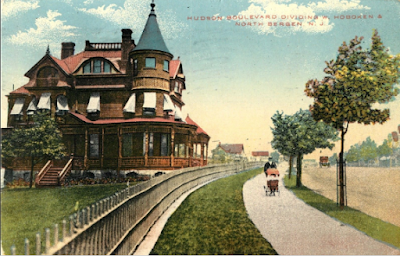"North Hudson County Park"
Recently, North Hudson County Park has begun to undergo a much needed facelift under Freeholder Anthony Vaineri. With the park rapidly approching it's 100th anniversry, it may be time to look at the man who laid out the master plan for the park way back in in the early 1900s. A man which most have seem to forgotten or never heard of at all, but is perhaps one of the most influencial landscape architects of his time.
Courtesy of Lenny DiBrango
It would take a walk through the park not very far from this spot for me to discover the man behind the layout of North Hudson Park. On a weathered copper plaque overlooking Woodcliff Lake those responsible for the parks names are immortalized as park goers, for perhaps the last century, walk by unaware. There are the names of those from the Hudson County Parks Commission, judges from the Pleas Court and a county secretary. But in the right hand corner is the name I was looking for. Landscape Architect, Charles Lowrie.
Country Life (1921)
Country Life (1921)
Lowrie was the county's choice architect. Born in Warrior's Mark, Pennsylvania and graduated from Yale University's Sheffield Scientific School in 1891. Afterwhich Lowrie was hired by the Hudson County Parks Commission and given direction to design several parks across the county. Each one of these parks Lowrie worked on are all still with us today, most famously Lincoln Park and Pershing Field in Jersey City, Bayonne Park in Bayonne, Columbus Park in Hoboken as well as West Hudson County Park in Kearny & Harrison. He was a founding member of the American Society of Landscape Architects (1899) and was a leading voice in the City Beautiful Movement, which most likely was the reason he was given the responsibility for designing Hudson County's Parks.
Courtesy of Lenny DiBrango
In the lead up to the parks opening in 1918 Hudson County was in desperate need of green space. The Hudson County Parks Commission established the need for two parks at first. The first being Lincoln Park (1905) in Jersey City and Bayonne Park (1916), now R. Gregg Hudson County Park, in Bayonne. The Commission established these two parks first due to the heavy industry along the Hudson River and throughout both cities. However, once residents of North Bergen learned of the parks, they too sought for the creation of a park in their own township.
Courtesy of Lenny DiBrango
The parks first comes to mention in 1908. Orginially it was pushed as an extension and complimentary park of the newly formed Palisades Interstate Park. It would take two more years for the park to get the offical OK. At the announcement Charles Lowrie feilded questions about the parks design. The features Lowrie highlighted were the parks 63 acres of woods and planted grounds, two and a half miles of gravel walking paths, as well as paths that will "wind in and out of the knolls and down the vales." He went on to reveal how the swamp would be converted into a freshwater feed lake (now Woodcliff Lake) and be to provide for adequate boating. The lake would also have a complimenting bandstand, which "will appeal strongly to park patrons." Lowrie envisioned a bandstand also on the island of the lake to "enable boats to cluster around it and still not prevent persons on the shore from hearing the music clearly." The architect continued on to explain his work touching on the drive that will run through the park and the sweeping vistas of New York City the park will provide from Boulevard East, especially that of the Sailors and Soilders Monument. Lowrie's plan for the park captived not only the Commisson but citizens of North Bergen as well and his plan for North Hudson County Park passed without objection.
The park has endured for almost 100 years and has acted as an oasis for the residents of North Bergen. We as residents of the town remeber the memories we've made in the park but often ignore the history. We are often never even told of the history as it is simply not known. Such as during the time the town was created the land than would become the park belong to James Ward, an Irish immigrant who farmed the land. Or during the Civil War the land was used as a drill ground for Hexamer's Battery. That prior to the county's decision to create the park the land was already subdivided and ready to be sold with the Racetrack subdivison. But thanks to Lowrie picturesque plan and the work of the Parks Commission the haven that is North Hudson County Park not only still exists, but is seeing a revival not only in usage but being reestablished as the finest park in Hudson County.







Comments
Post a Comment